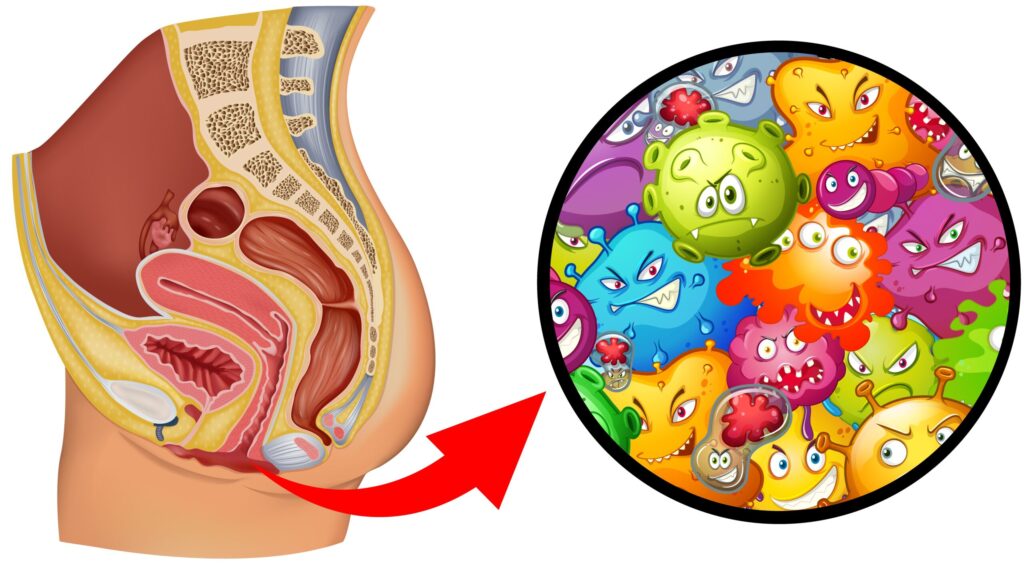Vaginal pH: What Causes Vaginal pH Imbalance?

Vaginal pH: Understanding Its Importance for Feminine Health
Hello, dear readers! In this blog post, we’re going to explore a key element of women’s health: vaginal pH. Even though it might seem technical, grasping the concept of vaginal pH is essential for preserving a healthy and harmonious intimate environment. Let’s explore what vaginal pH is, why it matters, and how you can support optimal vaginal health.
Decoding Vaginal pH
Vaginal pH refers to the measurement of acidity or alkalinity in the vaginal environment. The pH scale ranges from 0 to 14, with 7 being neutral. A pH below 7 is considered acidic, while a pH above 7 is alkaline. The vaginal pH is naturally acidic, typically ranging between 3.8 and 4.5. This slightly acidic environment is maintained by a delicate balance of microorganisms, primarily lactobacilli, which play a vital role in promoting vaginal health.
Importance of Balanced Vaginal pH
Maintaining the appropriate vaginal pH is essential for various reasons:
1. Protection Against Infections:
The acidic nature of the vagina helps prevent the overgrowth of harmful bacteria, fungi, and pathogens. It acts as a natural defense mechanism, reducing the risk of infections such as bacterial vaginosis, yeast infections, and urinary tract infections (UTIs).
2. Supporting Beneficial Microorganisms:
A balanced pH encourages the growth of lactobacilli, which are “good” bacteria. These bacteria produce lactic acid, which contributes to the vaginal environment’s acidity and discourages the growth of harmful microorganisms.
3. Fertility and Reproductive Health:
Optimal vaginal pH is essential for maintaining a conducive environment for sperm survival and movement. Changes in vaginal pH can impact fertility and conception.
Factors Influencing Vaginal pH
A variety of internal and external factors can influence the delicate balance of vaginal pH. Understanding these factors is essential for maintaining optimal vaginal health. Here’s an in-depth look at the factors that can impact vaginal pH:
1. Hormonal Fluctuations:
Hormones play a significant role in regulating vaginal pH. Changes in hormone levels throughout the menstrual cycle, pregnancy, and menopause can alter the vaginal environment’s acidity. For example, during ovulation, a temporary rise in pH can establish a more favorable environment for the survival of sperm.
2. Sexual Activity:
Sexual intercourse can introduce external substances into the vaginal environment, temporarily affecting pH. Semen, which is alkaline, can elevate pH levels for a short period. However, the vagina’s natural acidity generally restores balance after a while.
3. Menstrual Cycle:
During menstruation, the vaginal pH might become slightly more alkaline due to the presence of blood. This change is usually temporary and returns to its normal acidic state after the menstrual period.
4. Hygiene Practices:
Improper hygiene practices can disrupt the vaginal pH balance. Using scented products, douching, or harsh soaps can strip away the protective layer of beneficial bacteria, leaving the vagina more susceptible to infections.
5. Medications:
Certain medications, such as antibiotics, can indirectly influence vaginal pH by altering the balance of beneficial bacteria. Antibiotics, while essential for treating infections, can also temporarily disturb the equilibrium of the vaginal ecosystem.
Maintaining Healthy Vaginal pH
Keeping vaginal pH within the optimal range contributes to a healthier, more comfortable intimate environment. Here’s how you can maintain a balanced vaginal pH:
1. Practice Gentle Cleansing:
Clean the external genital area with mild, unscented soap and warm water. Avoid using harsh cleansers or douching, as they can disrupt the natural pH balance.
2. Choose pH-Friendly Intimate Products:
Opt for intimate products specifically designed to maintain a balanced pH. These products are formulated to be gentle and respectful of the vaginal ecosystem.
3. Incorporate Probiotics:
Probiotics can help support a healthy vaginal flora balance. Consuming probiotic-rich foods or taking supplements with Lactobacillus strains can encourage the growth of beneficial bacteria.
4. Hydrate and Maintain a Balanced Diet:
Staying hydrated and eating a balanced diet rich in nutrients can contribute to overall vaginal health.
5. Safe Sexual Practices:
If you’re sexually active, practicing safe sex not only protects against sexually transmitted infections but also minimizes pH disruption caused by semen.
Note: Pregnancy and Vaginal pH
For an upcoming blog post, we’ll delve deeper into the topic of vaginal pH during pregnancy. We’ll explore how hormonal changes influence pH levels, the potential implications for vaginal health, and practical tips for maintaining a balanced pH during this transformative journey. Stay tuned for an informative and empowering discussion on this important aspect of feminine health!
Feel free to reach out whenever you’re ready to explore this topic further. I’m here to assist you with any additional information you might need.
Empowering Vaginal Health
Comprehending the factors that impact vaginal pH and proactively working to sustain a healthy equilibrium empowers you to put your feminine well-being first. Regular communication with your healthcare provider and staying knowledgeable about vaginal health contribute to a confident and vibrant lifestyle.
Here’s to embracing your empowered journey toward vaginal health!


